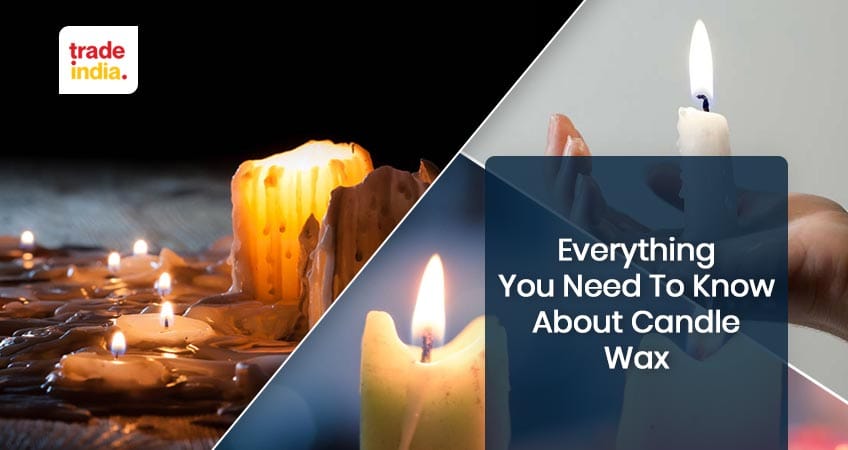Things You Need To Know About Candle Wax in 2025

Wax is a combustible as well as carbon-containing substance that transforms into liquid when it is heated above room temperature. In other words, it is the stuff that lights a candle. Warmth and light are produced as a result of combustion in the wax when the candle is lighted. It is possible to transform almost any type of oil into wax, thus there are many options for manufacturing candles.
Candles come in a variety of shapes and sizes, including pillars, containers, votives, tealight, and more. Wax for free-standing pillar candles must shrink to be released from the mold, however Candle wax for container candles must remain in the vessel when burning.
Candle-Wax Facts
- A beeswax candle was traditionally referred to as a "wax" candle before the nineteenth century.
- Hydrocarbons make up the majority of all waxes, whether they are animal, vegetable, or petroleum-derived. All candle waxes have the same chemical makeup, and they all burn in the same way.
- Candles sold in the United States each year utilize an estimated one billion pounds of wax.
- In North America, candles make for the second-largest usage of wax after packaging and coatings.
- A yellow flame is indicated by the existence of carbon in waxes.
- There is no "best" wax or wax blend for creating candles. All candle waxes have been demonstrated to burn cleanly, safely, and uniformly when delivered in a high-quality format.
- In the past, no candle wax was poisonous or damaging to the human body.
Top Leading Candle Wax Manufacturers In India
- Popatlal Jeshingbhai And Co,
- Arm Marketing Private limited
- Clear Vision Candles Pvt Ltd
- Solimo
- Bella Vita
- Prosperro Lumo
- Fakhruddin Lukmanji
What Creates Candle Wax?
There are a variety of waxes that may be used to make scented candles. In contrast to current waxes derived from coconut and petroleum, beeswax has been utilized in the making of candles for thousands of years.
Raw materials:
- Wick
- Paraffin
- Stearin
- Bees Wax
- Fats/oils
- Colors/lacquers
Some candle waxes are better at storing and transferring aroma than others, but all produce a clean, smoke-free flame when burned.
Scientists use the term "wax" to describe a broad range of materials, including but not limited to:
- At ambient temperature, the substance is solid; at higher temperatures, it becomes liquid.
- The majority of the structure is a hydrocarbon.
- It's water-repellent and water-insoluble.
- Under mild pressure, the surface is easily buffed away.
- Nontoxic; low sensitivity
- Low scent
Read More About: The Benefits of A Wax Candle for Your Home
Different Types of Candle Wax
1. Coconut Wax
Wax made from coconut is a relatively new development in the wax industry. Coconut wax, like soy wax, is more costly, but it is an environmentally beneficial option. Coconut oil is the primary ingredient in the production of coconut wax. Coconuts are also a renewable and sustainable crop.
You're seeing an increasing number of candle producers using coconut wax as a wax choice. As a result of its outstanding aroma, many people believe it is worth the price.
In addition to being environmentally beneficial, the candle wax price is a reasonable, creamy white tint. Coconuts themselves are a sustainable high-yield crop, making the oil harvesting process organic.
Benefits:
- These candles, made from coconut wax, burn for a long time and are exquisite.
- Coconut Candles have a great hot and cold smell throw.
- The most environmentally friendly option is coconut wax.
Specifications:
- Texture: Firm
- Color: Bright white to creamy and opaque
- Melting Temperature: 37°C (100 ºF).
- Scent: Odorless
- Price: Rs. 2,795
2. Paraffin Wax
The most prevalent kind of candle wax is paraffin. As a byproduct of crude oil refining and the oil industry, it is a source of petroleum-derived chemicals. At the very least, this portion of the oil is not wasted, but it is unsustainable in the long run.
Paraffin was the predecessor of both soy and coconut oil. Despite being a by-product of the oil industry, paraffin wax (also referred to as mineral wax) is nevertheless popular with many high-street candle companies because it maintains color and aroma exceptionally well.
Because paraffin wax is generated from crude oil refinement waste, it is typically seen as harmful by environmentalists
Benefits:
- As a result, if you desire your candles to have a strong aroma, mineral wax may be an excellent choice.
- A cheap and simple wax, but not one that's kind to the environment.
Specifications:
- Texture: Solid at room temperature
- Melting Temperature: between 46 and 68 °C (115 and 154 °F).
- Color: White
- Scent: Odorless
- Price: Rs 798
3. Soy Wax
Soy wax is seen as a more environmentally friendly alternative to paraffin wax. As a result, you feel it is the greatest candle wax at Homesick because of its numerous advantages.
As a bonus, because soy wax and soy wax mixtures burn more slowly, your candle will last longer. As a result, your Homesick Love candle will continue burning for many more years to come.
To get the best of both worlds, soy wax candles are frequently combined with other waxes. Additions of various oils and waxes, such as palm or beeswax, are common. Paraffin/soy mixes are also used by some candlemakers. Soy wax blends are often labeled as such if they include at least 51% soy.
Benefits:
- Because soy wax burns slowly, compared to traditional paraffin wax candles, you'll receive morcandlesle for your money when using soy wax.
- Natural, renewable, and biodegradable: Soybeans.
- However, it is more difficult to color than paraffin or beeswax because of its high melting point and ability to hold smells.
Specifications:
- Texture: Quite Soft and Pliable
- Melting Temperature: between 49 to 82 °C (120 to 180 °F).
- Color: Opaque white/beige
- Scent: Natural/forest like
- Price: Rs 1,357
4. Beeswax
Beeswax has a long and illustrious past, going back to ancient Egypt. Beeswax is an excellent choice for removing volatile organic compounds, but it has a big drawback: its honey fragrance. There are, of course, a few scents that don't mix well with honey.
In addition to being smoke and soot-free, beeswax candles actively cleanse the air. There are several ways to obtain beeswax, but the most common is through eating honey and making it part of the everyday routine of bees.
Beeswax is often mixed with different waxes by candle producers who create perfumed candles. The candles made by Boy Smells are made from a combination of coconut and beeswax, and you can see the selection here.
Benefits:
- Beeswax is produced and processed naturally.
- Beeswax is good for you and purifies the air.
- Beeswax is created during the honey-making process, and it's completely natural.
- Beeswax, on the other hand, is extremely pricey and not suitable for vegans.
Specifications:
- Texture: Solid
- Melting Temperature: 62 °C to 64 °C (144 °F to 147 °F).
- Color: Yellow and Brown
- Price: Rs 275
5. Rapeseed Wax
When it comes to candle wax, canola wax, or rapeseed wax, has recently become popular. There aren't many people in the United States who know that rapeseed comes from a yellow flower that blooms on mustard and cabbage-like plants. It is still regarded as a locally sourced resource in European countries.
Burning duration and smell retention are enhanced by the use of wax for candle making rapeseed wax (also referred to as Canola Wax). Newer candles are using it as an alternative to Soy Wax, which is more often used by independent businesses in Europe and the rest of the world.
Benefits:
- Locally produced rapeseed wax has a lower carbon impact than imported wax.
- A wax made from rapeseed has a strong smell that is easily dispersed and burns slowly.
- Excellent fragrance retention, a strong aroma throw, and a prolonged burn time are all provided by this product.
Specifications:
- Texture: Firm
- Color: White and beige
- Melting Temperature: 43°C (109 °F).
- Price: Rs 798
You have hundreds of fragrances from the world's most interesting candle companies, whether you like the perfume power of mineral wax candles or the environmentally friendly soy and rapeseed waxes. Even though gel candles seem very different from paraffin wax candles, they are very comparable in terms of environmental friendliness.
However, gel candles are still created from crude oil by-products, but the gel is treated differently to get the jelly-like consistency.
Gel wax candles have a slower burn rate than wax candles, which allows them to burn for a longer period.
| Top Candle Wax Price List | Expected Price |
|---|---|
| Candle Wax | 82.0 |
| 37 Degree C Melting Eco Friendly Fully Refined Candle Wax | 155.0 |
| Organic Soy Base Candle Wax | 275.0 |
| Organic Coconut Candle Wax | 365.0 |
| Modern Style 0.5 Oil Content Solid Form Beautiful Plain Wax Candles | 140.0 |
| Modern Solid Form Semi Refined Luma Led Real Wax Candles With Fragrance | 450.0 |
| Industrial Grade Fully Or Semi Refined Paraffin Candle Wax | 150.0 |
| Table Wax | 19.0 |
| Table Wax | 19.0 |
| Petroleum Wax | 19.0 |
FAQs: Candle Wax
Q. Which candle wax is best?
Ans. Because each candle wax has its advantages and disadvantages, picking a winner is difficult. So many different kinds of candle wax (and candle wax mixtures) are available because of this fact. In the following sections, they explain the pros and cons of each type of wax, so that you may make an informed decision about which one is ideal for you.
Q. Is the use of gel candles environmentally friendly?
Ans. Because they are made from a byproduct of crude oil processing, gel candles are not environmentally friendly. Drilling for crude oil has the potential to pollute the environment and decimate wildlife habitats.
Q. Are wax candles safe?
Ans. In terms of toxicity, there is no conclusive evidence that gel candles are dangerous. It's been reported that paraffin candles, which are also comprised of wax, can leak carcinogens like benzene and toluene into the air. Wax candles, on the other hand, are not.
Explore More:
